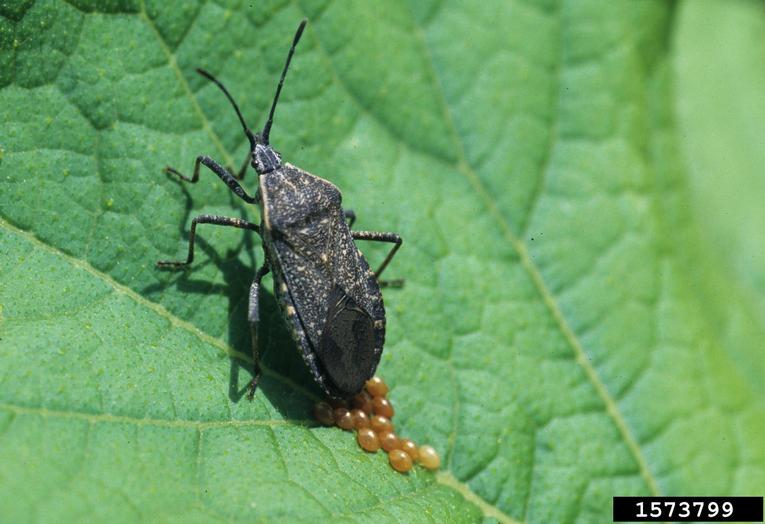Integrated Pest Management (IPM)

Characteristics
Squash bugs have piercing and sucking mouthparts that they use to feed on cucurbits such as squash or pumpkins. This pests can make the plants sick through feeding and disease transmission. Squash bugs take a long time to mature (~8 weeks) during which time the immature stages (nymphs) and adults feed alongside one another causing much of the crop loss. Squash bugs produce shiny red eggs in clusters on various plant parts. The nymphs hatch in about seven days in hot weather and remain young for about a month.
Nymphs tend to stay in clusters for protection. Nymphs are grayish and look like adult bugs, but nymphs lack wings. Adult squash bugs are large, somewhat flattened insects that hide well under debris, plant leaves, soil cracks, or under the plastic mulch. Under extreme dry conditions, adults often hide under the plastic or soil debris remaining close to the drip lines for moisture. In other words, good scouting practice for squash bugs include looking for egg masses and nymphs under the small or large leaves and around the plant base.
Damage
Crop damage happens when the bugs inject a toxic saliva into the plant. Large aggregations can cause plants to wilt gradually. Under drought conditions, this wilting becomes more intense and can even kill the mature plants reducing yields. Squash bugs also vector a bacterial disease called cucurbit yellow vine decline (CYVD), which has become a major issue in the Southeastern United States over the past decade. Squash bugs carry the bacteria inside the body throughout life and cause rapid increase in disease incidence during migration from plant-to-plant or field-to-field. Once the CYVD bacterium is inside the plants, there is no cure for the disease.
IPM Recommendations
Squash bugs are difficult insects to manage in organic or low-input production systems. Squash bugs have natural enemies like the tachnid fly (Trichopoda), but these flies are generally slow to kill the pest during which time the squash bugs continue to feed on plants. Selecting good, fast-growing hybrid plants can help reduce the effects of stressful environmental conditions and feeding injury.
A pest exclusion system using spun-bounded polyester fabric, such as Super Light Insect Barrier (Gardens Alive) or AgroFabric Pro fabric (Seven Springs Farm), immediately after seeding or transplanting and continuing through flower initiation can deter squash bug infestation and allow plants to grow under protection. Take the fabric off during flowering to allow insect pollinators to do their job. The practicality of using pest exclusion on a large-scale can be cost prohibitive. High tunnel producers can use a permanent exclusion system with 55% or higher shade cloth to slow down or deter adult squash bugs
For medium-sized organic operations, using a hubbard squash trap crop with mixed stands of ‘Baby Blue’ and ‘New England’ hubbard squash can be distracting to squash bugs. This distraction can protect the main crop from feeding damage. Nymphs can be killed in the trap crop with organic insecticides as discussed below.
Organic insecticides for killing squash bugs include only a few products with spinosad and pyrethrin as their active ingredients. The major issues with contact insecticides is the problem of getting the product where the insects are hiding. Nymphs are more susceptible to insecticides compared to the adults.
Synthetic pyrethroid insecticides can be effective, but often supply a short-term solution and require multiple applications. Many Group 4A neonicotinoid and some Group 3 synthetic pyrethroid insecticides (bifenthrin, zeta-cypermethrin and lambda-cyhalothrin among others) are effective against squash bugs but have many use restrictions on the insecticide label. Group 4A insecticides have contact and translaminar action (e.g., dinotefuran) whereas synthetic pyrethroids provide excellent short-term contact action against the pests. Refer to the Southeastern U.S. Vegetable Crop Handbook for complete insecticide recommendations. Consult a regional extension agent for proper insect identification, learn proper scouting practices, and develop an IPM plan appropriate for your farm or garden.
Use the Farming Basics Mobile App for looking up IPM videos on various trap cropping and pest exclusion IPM tactics.

